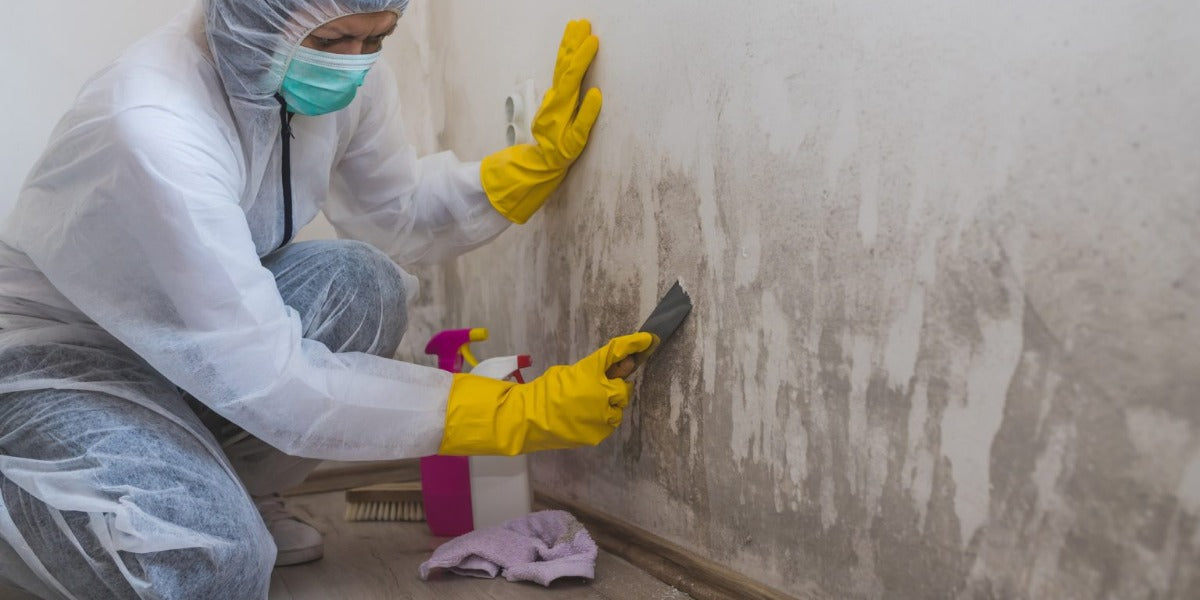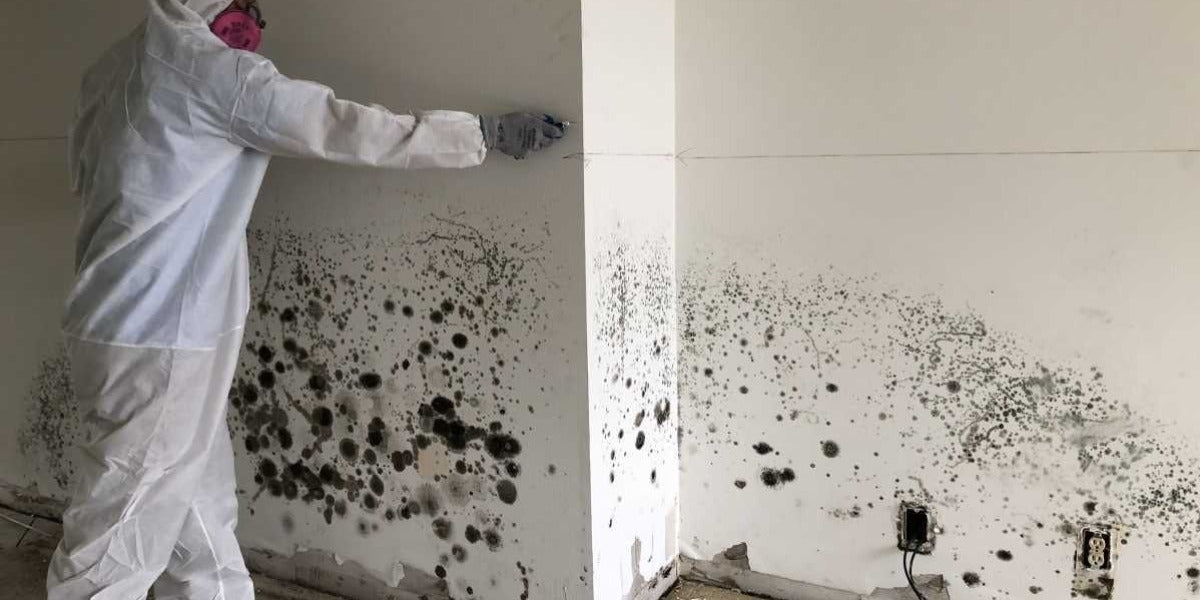Moldy walls in basements can be a result of moisture. So if your basement is damp, be sure to know that molds are potentially multiplying too. But how does this apply to your health and your home?
For most people, they deny immediate attention to moldy walls especially in basements because it’s out of sight. This neglect goes on to be a major problem later on. This mold that goes ignored can release tiny spores into the air, which you may inhale.
As you are probably aware, mold can be a potentially hazardous nuisance, contributing to infections, respiratory issues (like nasal congestion and wheezing), allergies, and irritation (itchy eyes or skin). Moldy walls can also cause irritating odors in your home, degrade the aesthetic value of your home, and significantly weaken your home structure. This means immediate action is actually needed to remove all the molds before it gets worse.
Since you’re reading this, you’re in luck because you’ll take away the best mold removal methods you can apply today. You’ll discover how to remove mold from basement walls, and this guide will provide you with step-by-step instructions and helpful tips. No more searching for “how to remove mold from basement walls” or “how to remove mold from walls in basement”
Understanding What Causes Mold in Basements
Before we reveal how to remove mold from basement walls, it's crucial to understand why it grows in the first place. What causes mold in basements? The answer lies in these underground spaces' unique conditions.
There are certain conditions that must be met for mold and spores to thrive in the basement. But most of the time, what causes mold in basements often comes down to excess humidity and lack of ventilation. Here are other factors that can trigger mold growth:
Poor Ventilation
One of the most common causes of mold in basements is poor ventilation. Inadequate air circulation prevents moisture from evaporating and allows mold to flourish in stagnant air. This lack of proper ventilation also promotes high humidity, creating an ideal environment for mold growth.
Flooding
Basement flooding can cause water damage and mold growth. Floods result in a substantial accumulation of water, causing hydrostatic pressure to build up. This pressure eventually leads to leaks, moisture, and the subsequent growth of mold.
High Humidity
When your humidity levels are high, mold will definitely grow. This is because high humidity translates into moisture which is the perfect condition for mold growth.
Organic Materials
Organic matter is often found in basements, like paper, wood, and drywall. Mold feeds on these organic materials which increases its growth.
Faulty Sump Pump
When your sump pump fails or is not functioning properly, it can lead to flooding in your basement. This, in turn, leads to moisture problems and creates the perfect environment for mold to grow.
Leaks or Cracks
Leaks and cracks in the basement can cause mold if a whiff of moisture penetrates it either through rainfall or floods.
Types of Molds
These are the types of molds that will ever infest your basement ranked in the order of the least dangerous to the most dangerous:
Least Dangerous
Cladosporium:
While this mold is common and can cause respiratory problems in some people, it's generally considered less harmful than others on this list. It's often found on painted surfaces, wood, or wallpaper.
Alternaria:
Like Cladosporium, Alternaria can trigger allergies and asthma symptoms. It thrives in damp areas and often appears on food, plants, and textiles.
Moderately Dangerous
Aspergillus:
This mold is more concerning because certain species can produce mycotoxins, harmful substances that can cause various health issues. However, not all Aspergillus species are toxic. It's often found in HVAC systems, dust, and decaying vegetation.
Fusarium:
This mold also produces mycotoxins and can lead to respiratory problems and other illnesses. It favors damp environments and can grow on various materials, including carpets and wallpaper.
Most Dangerous
Stachybotrys chartarum (Black Mold):
This is the most notorious and dangerous mold on the list. Its mycotoxins can cause severe respiratory problems, and neurological issues, and even suppress the immune system. Black mold requires immediate professional remediation.
Important Note: The severity of mold-related health issues can vary greatly depending on the individual, the amount of mold present, and the length of exposure. If you have any concerns about mold in your basement, it's always best to consult with a professional for assessment or seek basement mold remediation.
Effective Mold Removal Methods for Basement Walls
Before you apply the mold removal methods, it’s important you’re well suited in your personal protective equipment. Doing this will protect you from the chemicals and the potential release of mold spores.
Here are a few essential tools that will help you on your quest on how to remove mold from walls in basement:
Protective gear: Headcover, overalls, gloves, goggles, and a mask.
Cleaning solutions: Vinegar, bleach, detergent, or commercial mold removers.
HEPA Air Scrubber: This device helps filter out mold spores from the air, improving indoor air quality and reducing the risk of re-infestation.
An important side note: Mold growth is just a symptom of a larger problem which may be one of the various causes mentioned above. So, it’s advisable to fix the underlying issues before you go ahead to remove the mold. If not addressed, mold infestations will recur.
How to Remove Mold from Concrete Basement Walls
After addressing the underlying issues, you can apply the following mold removal methods:
Natural Solutions
Tea tree Oil: Tea tree oil is a natural fungicide and a potent solution to remove mold from walls in basements. Add a few drops of tea tree oil to water, and spray onto moldy areas.
Grapefruit Seed Extract: This natural disinfectant and fungicide can be mixed with water and used in a spray bottle. Mix with water, spray onto moldy areas, let it stand for about 5 minutes, then wipe clean. It not only kills mold but also prevents regrowth and inhibits its spread.
Vinegar: This household staple is a natural cleaning powerhouse. Simply mix equal parts white vinegar and water in a spray bottle, apply to moldy areas, let sit for five minutes, and wipe clean. Vinegar effectively kills mold and works on both porous and non-porous surfaces. One of the reasons vinegar is widely recommended is because it's safe for most surfaces.
Borax: A natural cleaner with antifungal properties, borax can be mixed with water to create a paste and applied to moldy areas. Remember to mix thoroughly, as borax can be toxic if ingested. After applying borax to the moldy areas, wipe the surface clean with a brush or sponge.
Hydrogen Peroxide: This non-toxic and non-irritating solution can be diluted with water and applied to moldy areas. It's gentle on surfaces yet effective against mold. After applying to the surface, let it sit for a few minutes before wiping clean.
Commercial Solutions
Concrobium: This is an EPA-registered mold remediation product that comes in powder form and can be used by adding water. The edge this product has is its ability to prevent the recurrence of mold spores. The not-so-good part is the cost and toxicity. Although it’s less toxic than bleach, you need to exercise caution during use.
Specialized Equipment
HEPA Air Scrubber: For a thorough approach, consider using a HEPA air scrubber. It not only removes mold from the air, preventing it from spreading but also captures other allergens and pollutants, improving overall air quality. This is particularly beneficial for those with allergies or sensitivities.
High-Efficiency Particle Absolute (HEPA) Vacuum Machines: These vacuums effectively remove mold from basement walls and capture airborne spores. For high-humidity areas, consider a vacuum with a water filter to prevent further mold growth. Always wear a mask when using a HEPA vacuum, as it can release harmful particles.
Bleach
While often used for mold removal, bleach is not the most effective option as it may not kill all mold spores and can be harmful to your health. Additionally, it doesn't penetrate porous materials to eliminate the roots. Therefore, it's not the most recommended option.
Ensure you exercise caution with bleach if your basement is poorly ventilated
How to Prevent Mold in Your Basement
Preventing mold growth in your basement is far easier than dealing with an infestation. Here's what you can do:
Control Moisture: Fix any leaks or cracks in your foundation and ensure your sump pump is functioning correctly.
Dehumidify: Use a dehumidifier and monitor humidity levels in humid areas, keeping them below 60%.
Seal Your Foundation: Seal your foundation with dry gypsum wall and primer to prevent water from seeping in.
Proper Grading: Ensure the ground slopes away from your home to prevent water pooling around the foundation.
Clean Gutters: Keep gutters clear to direct water away from your home.
Mold-Resistant Paint: Use a mold inhibitor in your paint to deter mold growth.
When to Call Professionals for Basement Mold Removal
While DIY methods are suitable for minor mold problems, there are situations where it's best to call in the experts:
Contaminated Water: If the mold growth is due to sewage or other contaminated water, professional basement mold remediation is essential to prevent health risks.
Extensive Mold Growth: If the mold covers a large area (more than 10 square meters), it's difficult to contain the spores and remove them effectively without professional help.
Persistent Mold: If mold keeps returning despite your cleaning efforts, it could indicate a hidden moisture problem that needs to be addressed by a professional.
Health Concerns: If you or your family members have allergies or respiratory issues, it's best to avoid exposure to mold and seek professional assistance.
Inaccessible Mold: If the mold is growing in hard-to-reach areas or within your HVAC system, professionals have the tools and expertise to address it safely.
By recognizing the signs of a serious mold outbreak and seeking professional help when needed, you can ensure the safe and effective removal of mold from your basement, protecting your health and the value of your home.
The best moment to seek professional basement mold remediation is when the mold infestation is large or you don’t know what type of mold you’re dealing with. Otherwise, most situations can be handled if the techniques above are applied carefully.
Let Abestorm Help You in Your Mold Removal Process
The mold removal process might feel overwhelming at times. Let us help you shave off hours of work. The HEPA air scrubbers in our store can help you eliminate major mold spores from the air in minutes. This is especially effective while cleaning so the mold spores that get released don’t float through the air to breed again.
Click here now to claim your enormous spring discount on our HEPA air scrubbers. These deals are seasonal so don’t miss out on protecting your home and especially your health.









Shop For Dehumidifier